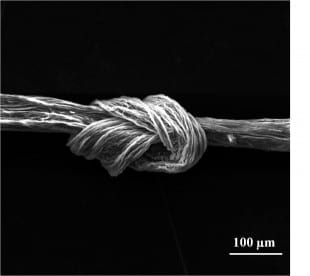
New material created at Rice University with graphene oxide flakes
Large flakes of graphene oxide are the essential ingredient in a new recipe for robust carbon fiber created at Rice University.
The fiber spun at Rice is unique for the strength of its knots. Most fibers are most likely to snap under tension at the knot, but Rice’s fiber demonstrates what the researchers refer to as “100 percent knot efficiency,” where the fiber is as likely to break anywhere along its length as at the knot.
The material could be used to increase the strength of many products that use carbon fiber, like composites for strong, light aircraft or fabrics for bulletproof apparel, according to the researchers.
“To see this is very strange,” Tour said. “The knot is as strong as any other part of the fiber. That never happens in a carbon fiber or polymer fibers.”
Credit goes to the unique properties of graphene oxide flakes created in an environmentally friendly process patented by Rice a few years ago. The flakes that are chemically extracted from graphite seem small. They have an average diameter of 22 microns, a quarter the width of an average human hair. But they’re massive compared with the petroleum-based pitch used in current carbon fiber. “The pitch particles are two nanometers in size, which makes our flakes about ten thousand times larger,” said Rice graduate student Changsheng Xiang, lead author of the new paper.
Like with pitch, the weak van der Waals forceholds the graphene flakes together. Unlike pitch, the atom-thick flakes have an enormous surface area and cling to each other like the scales on a fish when pulled into a fiber. The wet-spinning process is similar to one recently used to createhighly conductive fibers made of nanotubes, but in this case Xiang just used water as the solvent rather than a super acid.
Bendability at the knot is due to the fiber’s bending modulus, which is a measure of its flexibility, Xiang said. “Because graphene oxide has very low bending modulus, it thinks there’s no knot there,” he said.
Tour said industrial carbon fibers — a source of steel-like strength in ultralight materials ranging from baseball bats to bicycles to bombers — haven’t improved much in decades because the chemistry involved is approaching its limits. But the new carbon fibers spun at room temperature at Rice already show impressive tensile strength and modulus and have the potential to be even stronger when annealed at higher temperatures.
Heating the fibers to about 2,100 degrees Celsius, the industry standard for making carbon fiber, will likely eliminate the knotting strength, Xiang said, but should greatly improve the material’s tensile strength, which will be good for making novel composite materials.
The Latest Bing News on:
Carbon fiber
- Mansory has fitted the Spectre with an orange interior and loads of carbon fiberon April 28, 2024 at 1:14 am
Unusually for Mansory, there isn’t actually any more power. The German tuner has decided to stay well away from the Spectre’s electric powertrain, meaning you’ll be stuck with the standard 576hp and ...
- Manfrotto Befree Advanced Carbon Fiber travel tripod reviewon April 27, 2024 at 9:14 pm
Just like the best travel tripods, the Manfrotto Befree Advanced Carbon Fibre Travel Tripod excels when it comes to these prerequisites. It collapses into a carry-on sized package, is light enough to ...
- Landrum to see carbon fiber bike manufacturing near Saluda Grade Rail Trail, what to knowon April 27, 2024 at 3:40 am
Another carbon fiber bicycle element manufacturer is headed for the Saluda Grade Rail Trail. During the Criterium bike race on Friday, April 26, Boyd Cycling announced they would bring Munich ...
- Would You Put Carbon Fiber Skins On Your McLaren’s Alloy Wheels?on April 26, 2024 at 5:27 pm
The McLaren 720S wasn’t just a hugely important car for the British manufacturer but it was also pivotal for the supercar industry as a whole, achieving levels of performance previously unheard of for ...
- Local cycling companies acquire German carbon rim makeron April 26, 2024 at 4:00 pm
Two Upstate cycling manufacturers and a group of local investors have acquired a German carbon rim manufacturer and are moving production equipment to Spartanburg County. Greenville’s Boyd Cycling ...
- Record Revenue & Beyond: Join Fireside with CEO of Carbon Revolution May 1 at 4PM ETon April 26, 2024 at 2:08 pm
IPO Edge and the Palm Beach Hedge Fund Association will host a fireside chat with Carbon Revolution(Nasdaq: CREV) on May 1 at 4 PM ET to discuss the company’s record revenue results, the ...
- Unplugged Performance Launches Carbon Fiber Tesla Model 3 Performance Aero Kiton April 26, 2024 at 7:56 am
The go-to guys for modified Teslas have released several effective aero upgrades for the 510-HP Tesla Model 3 Performance.
- 2024 Tesla Model 3 Performance With Unplugged Performance Carbon Aero Kit Looks Terrificon April 25, 2024 at 10:14 am
If $7,430 is too much, fet not because all of the aerodyamic kits pre-preg carbon parts are available as standalone items as well ...
- Carbon Fiber Market Projected to Surpass USD 17.82 Billion by 2031, Driven by Surging Demand in Automotive and Aerospace Industrieson April 22, 2024 at 6:38 am
Carbon Fiber Market Projected to Surpass USD 1782 Billion by 2031 Driven by Surging Demand in Automotive and Aerospace Industries ...
- The Bicycle Day Dream Bike: A Carbon Fiber Hommage To Albert Hofmannon April 19, 2024 at 5:00 am
Bicycle Day holiday, celebrating Albert Hofmann and the first LSD trip, a carbon fiber mountain bike frame is transformed into a work of art ...
The Latest Google Headlines on:
Carbon fiber
[google_news title=”” keyword=”carbon fiber” num_posts=”10″ blurb_length=”0″ show_thumb=”left”]
The Latest Bing News on:
Novel composite materials
- UMaine’s novel polymer 3D printer surpasses former Guinness World Recordon April 26, 2024 at 6:03 pm
Four times larger than its predecessor, FoF 1.0 offers new opportunities in composite materials, including development of recycled and bio-based materials.
- Novel Anode Material Boosts Lithium-Ion Battery Performanceon April 25, 2024 at 9:16 am
Reviewed by Lexie Corner Dr. Han Joong Tark and student researcher Lee Do Geun at Korea Electrotechnology Research Institute's Nano Hybrid Technology Research Center have devised a novel manufacturing ...
- Towards novel promising perovskite-type ferroelectric materials: High-pressure synthesis of rubidium niobateon April 24, 2024 at 5:00 pm
Researchers have pioneered a breakthrough in ferroelectric material development. They've engineered a novel displacement-type ferroelectric material boasting remarkable dielectric properties. Their ...
- How much does a new roof cost?on April 24, 2024 at 5:03 am
A new roof can cost thousands of dollars but whether you pay $10,000 or more depends on your roof size and materials. Find out where you stand.
- Composite Resins Power Innovation in Automotive & Construction – Market to Hit US$ 48 Billion by 2034on April 22, 2024 at 2:52 am
The composite resin market is expected to reach a valuation of US$ 25.1 billion in 2024. The industry is projected to be worth US$ 48 billion by 2034, expanding at a CAGR of 6.7% between 2024 and 2034 ...
- New 2D material manipulates light with remarkable precision and minimal losson April 21, 2024 at 5:00 pm
More information: Ghada Dushaq et al, Electro-optic tuning in composite silicon photonics based on ferroionic 2D materials, Light: Science & Applications (2024). DOI: 10.1038/s41377-024-01432-2 ...
- Novel material supercharges innovation in electrostatic energy storageon April 19, 2024 at 6:10 pm
Scientists have developed artificial heterostructures made of freestanding 2D and 3D membranes that have an energy density up to 19 times higher than commercially available capacitors.
- Novel material supercharges innovation in electrostatic energy storageon April 17, 2024 at 5:00 pm
Kim and postdoctoral researcher Sangmoon Han developed novel 2D/3D/2D heterostructures that can minimize energy loss while preserving the advantageous material properties of ferroelectric 3D ...
- Novel Approach to Produce Multi-Color Phosphorescent Carbon Dotson April 17, 2024 at 11:04 am
A new technique for creating carbonized polymer nanodots that can emit multicolored, ultra-long Room-temperature phosphorescent (RTP) from blue to green has recently been developed.
- Quantum Stretch: Unveiling the Future of Elastic Displayson April 17, 2024 at 4:08 am
Intrinsically stretchable quantum dot-based light-emitting diodes achieved record-breaking performance. A team of South Korean scientists led by Professor KIM Dae-Hyeong of the Center for Nanoparticle ...
The Latest Google Headlines on:
Novel composite materials
[google_news title=”” keyword=”novel composite materials” num_posts=”10″ blurb_length=”0″ show_thumb=”left”]










